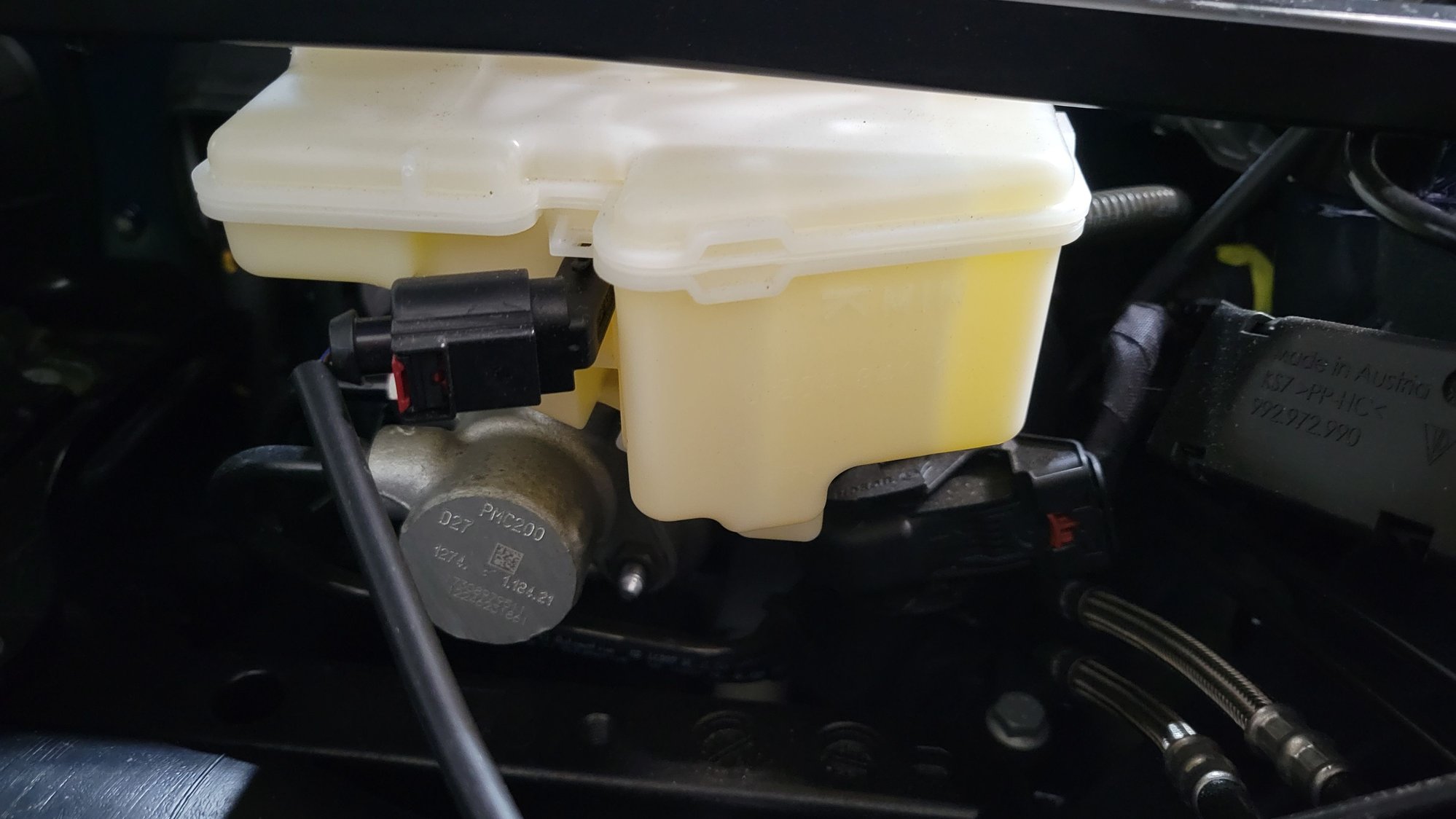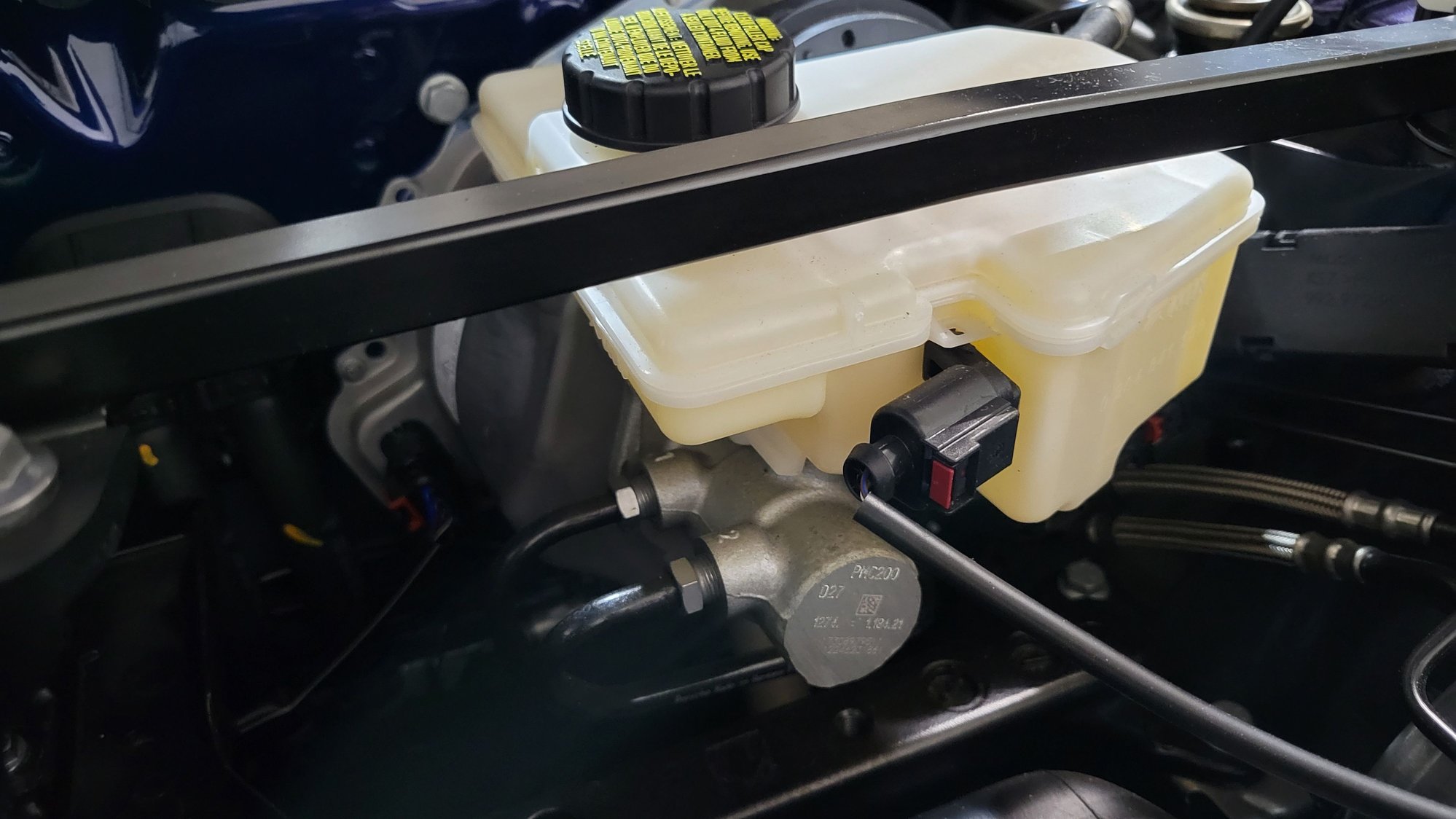991 Brake Bleed/Flush Procedure
#76
Drifting
resurrecting this thread as it seems most participants know a thing or two. Also, i have a 992, but that group doesn't seem to do as much DIY so figuring i'd get better answers here, so hopefully somebody here can shed some light. I'm assuming our brake systems are pretty similar...
Been doing brake bleeds for 20 years on my cars, and always used the wet pressure pump method (filling Motiv pump bleeder, pressurized, bled each caliper, and done). I decided to try the dry method recently, but when i pressurized the Motiv, then drained 6 oz from one of the calipers, the reservoir level didn't budge. That freaked me out. Was i draining fluid from somewhere and adding air?? no idea, so i went back to my normal way. Bled all 4 corners with some extra fluid and all seemed fine. But i really want to know why the reservoir level didn't change.
And i was curious about how much the fluid reservoir holds to begin with (so future bleeds i know how much i need to pump through before it even gets to the lines), so today I went and tried to extract fluid from the reservoir using a hand pump extractor (turkey baster seemed like it was going to take forever, after a few iterations, so moved to the extractor... and yes, i pulled out the yellow filter screen). I extracted out 7 oz, and the reservoir was still almost at max. WTF?? Where was this fluid coming from??
I did a quick bleed of my front left caliper to try and get the fluid levels back to normal. Filled the Motiv with 16 oz of fresh fluid. By the time it was pretty empty, i had drained 12 oz from the caliper. So that 12+7=19oz, but only added 16. Reservoir still at max. Drove the car around, pedal and braking seem fine.
I'm so confused. anybody have insights?
Been doing brake bleeds for 20 years on my cars, and always used the wet pressure pump method (filling Motiv pump bleeder, pressurized, bled each caliper, and done). I decided to try the dry method recently, but when i pressurized the Motiv, then drained 6 oz from one of the calipers, the reservoir level didn't budge. That freaked me out. Was i draining fluid from somewhere and adding air?? no idea, so i went back to my normal way. Bled all 4 corners with some extra fluid and all seemed fine. But i really want to know why the reservoir level didn't change.
And i was curious about how much the fluid reservoir holds to begin with (so future bleeds i know how much i need to pump through before it even gets to the lines), so today I went and tried to extract fluid from the reservoir using a hand pump extractor (turkey baster seemed like it was going to take forever, after a few iterations, so moved to the extractor... and yes, i pulled out the yellow filter screen). I extracted out 7 oz, and the reservoir was still almost at max. WTF?? Where was this fluid coming from??
I did a quick bleed of my front left caliper to try and get the fluid levels back to normal. Filled the Motiv with 16 oz of fresh fluid. By the time it was pretty empty, i had drained 12 oz from the caliper. So that 12+7=19oz, but only added 16. Reservoir still at max. Drove the car around, pedal and braking seem fine.
I'm so confused. anybody have insights?
The following users liked this post:
achilleas101 (01-31-2024)
#77
Racer
Checking out the parts catalog I guess the reservoir is new for the 992 so maybe not going to get as many people with insight as I'd hoped.
 will try to see if i can get a better internal view.
will try to see if i can get a better internal view.

#79
I have no explanation for the apparent difference in fluid out and fluid in observed by the man with the 992 Porsche. I've never experienced anything similar on any of my cars, and I have been bleeding brakes since the late 1960s.
There must be at least two compartments within the brake fluid reservoir so that if/when one braking circuit fails and loses its fluid, the other will continue to function to enable the vehicle to be stopped. That is accomplished by the design of the brake master cylinder pistons and seals together with the design of the metal housing in which that piston can move. If the braking equipment served by rear-most portion of the piston and its seals fails and leaks fluid, when the brake pedal is depressed that section is sealed off from the rest of the system served by the front-most piston and its seals and its fluid chamber and thus it will continue to function. The same is true if the front-most section fails; the rear-most section will continue to function to stop the vehicle in an emergency. Most reservoir designs also have a high level fluid output tube molded into the plastic reservoir that is sealed off in vehicles with an automatic transmission but is opened and connected with a hose to the clutch master cylinder in manual transmission cars.
I have a 2017 C2S with PDK. The brake fluid reservoirs on all of my European cars [multiple BMWs, a couple of SAABs and three Audis and my Porsche] have always had a two-chamber molded translucent plastic reservoir. The BMWs and one of the Audis had MTs and thus had the extra fluid hose connection.
All of them used the same size and thread pitch cap, and I have been using the same machined anodized aluminum cap which has a silicone rubber gasket and a standard male air hose nipple together with pressurized air from an air compressor equipped with a quality air pressure regulator that will also allow bleeding off air pressure when the **** is rotated to reduce the output pressure.to change brake fluid in these cars since the early 1980s. My approach is to first siphon or suck out [with a turkey baster] as much of the old fluid as possible, then to fill the reservoir with new fluid, then screw on the air pressure cap, then proceed with bleeding of the calipers. I use a translucent fluid catch bottle and note how much fluid is in it when I start and stop bleeding fluid before I fully drain the reservoir to avoid introduction of air into the system. A couple of pieces of blue masking tape can be used as a marker to denote the amount of fluid that is bleed from any brake caliper nipple. I move a lot more fluid from the first bleeder nipple than from the rest since that will move out most of the old fluid remaining in the reservoir as I start the fluid change cycle.
If you need to bleed a clutch slave cylinder and the arrangement of the lines and slave cylinder are such that you cannot get the air out of the slave cylinder [a not uncommon problem], try connecting a length of plastic [vinyl] tubing from the left front caliper bleed nipple to the nipple on the slave cylinder and gently pushing fluid from the brake caliper to and through the slave cylinder. If you have a Motive pressure bleeder or similar tool, you can simply connect it to the slave cylinder nipple to reverse flush the slave cylinder. If you need to do that, I suggest you do it first to avoid contaminating the fresh brake fluid you intend to pour into the reservoir after removal of the old fluid.
There must be at least two compartments within the brake fluid reservoir so that if/when one braking circuit fails and loses its fluid, the other will continue to function to enable the vehicle to be stopped. That is accomplished by the design of the brake master cylinder pistons and seals together with the design of the metal housing in which that piston can move. If the braking equipment served by rear-most portion of the piston and its seals fails and leaks fluid, when the brake pedal is depressed that section is sealed off from the rest of the system served by the front-most piston and its seals and its fluid chamber and thus it will continue to function. The same is true if the front-most section fails; the rear-most section will continue to function to stop the vehicle in an emergency. Most reservoir designs also have a high level fluid output tube molded into the plastic reservoir that is sealed off in vehicles with an automatic transmission but is opened and connected with a hose to the clutch master cylinder in manual transmission cars.
I have a 2017 C2S with PDK. The brake fluid reservoirs on all of my European cars [multiple BMWs, a couple of SAABs and three Audis and my Porsche] have always had a two-chamber molded translucent plastic reservoir. The BMWs and one of the Audis had MTs and thus had the extra fluid hose connection.
All of them used the same size and thread pitch cap, and I have been using the same machined anodized aluminum cap which has a silicone rubber gasket and a standard male air hose nipple together with pressurized air from an air compressor equipped with a quality air pressure regulator that will also allow bleeding off air pressure when the **** is rotated to reduce the output pressure.to change brake fluid in these cars since the early 1980s. My approach is to first siphon or suck out [with a turkey baster] as much of the old fluid as possible, then to fill the reservoir with new fluid, then screw on the air pressure cap, then proceed with bleeding of the calipers. I use a translucent fluid catch bottle and note how much fluid is in it when I start and stop bleeding fluid before I fully drain the reservoir to avoid introduction of air into the system. A couple of pieces of blue masking tape can be used as a marker to denote the amount of fluid that is bleed from any brake caliper nipple. I move a lot more fluid from the first bleeder nipple than from the rest since that will move out most of the old fluid remaining in the reservoir as I start the fluid change cycle.
If you need to bleed a clutch slave cylinder and the arrangement of the lines and slave cylinder are such that you cannot get the air out of the slave cylinder [a not uncommon problem], try connecting a length of plastic [vinyl] tubing from the left front caliper bleed nipple to the nipple on the slave cylinder and gently pushing fluid from the brake caliper to and through the slave cylinder. If you have a Motive pressure bleeder or similar tool, you can simply connect it to the slave cylinder nipple to reverse flush the slave cylinder. If you need to do that, I suggest you do it first to avoid contaminating the fresh brake fluid you intend to pour into the reservoir after removal of the old fluid.


